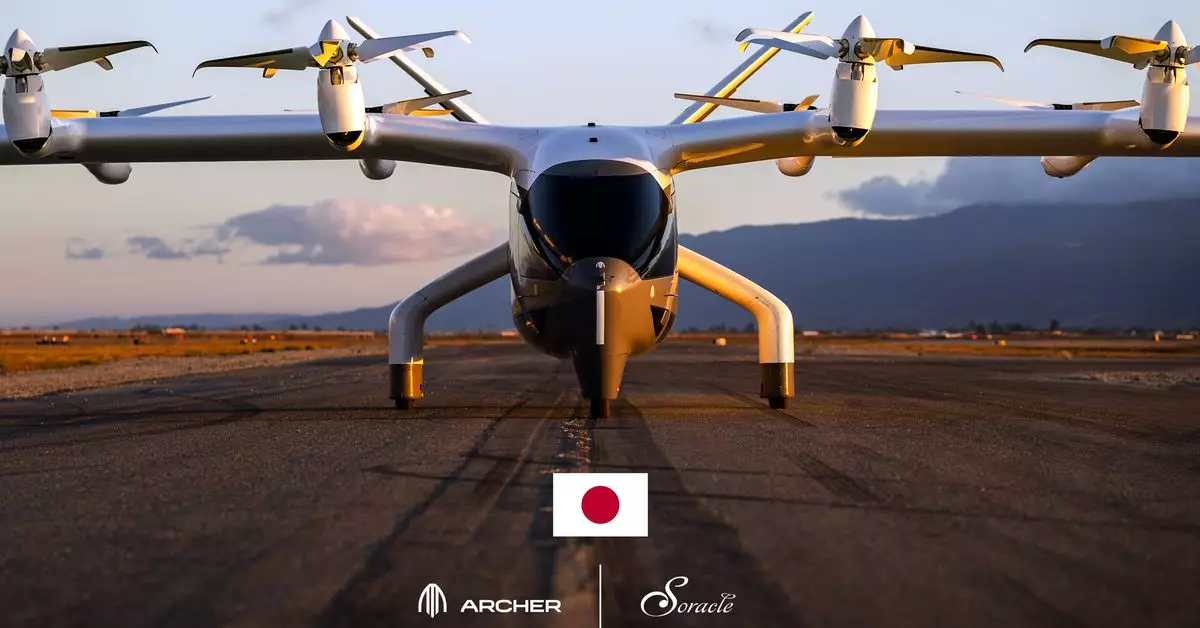As technological advances reshape the aviation landscape, electric air taxis are making a significant impact on urban transportation. Archer Aviation, based in San Jose, California, emerges as a pioneering entity in this domain, preparing to introduce its innovative Midnight battery-powered aircraft to Japan. This strategic move, in partnership with Soracle—a collaboration between Japan Airlines and Sumitomo Corporation—marks a noteworthy stride in Archer’s ambition to transform urban mobility through aerial solutions.
Archer Aviation is set to sell 100 units of its Midnight aircraft to Soracle in a transaction valued at around $500 million. This agreement highlights the growing interest and investment in electric flight technologies, particularly in regions where conventional ground transportation presents challenges due to traffic congestion or geographical constraints. However, this partnership comes with contingencies; Archer must meet specific benchmarks in aircraft delivery before Soracle commits to any pre-delivery payments. This underscores the critical nature of performance and reliability in the nascent electric aviation sector.
The acquisition of these aircraft represents not just a financial transaction but also serves as a vote of confidence in Archer’s technology and long-term vision. In unveiling their Midnight aircraft, Archer places emphasis on the demand for alternative transportation solutions in densely populated urban environments, where airborne vehicles could mitigate current transportation woes.
Midnight is characterized by its compact size, accommodating four passengers and a pilot, enabling it to function effectively in urban settings. With an operational range of up to 100 miles and speeds reaching 150 mph, the aircraft is specially designed for short, repeated flights. Furthermore, the Midnight’s ability to use tilt rotors allows it to take off and land vertically—an essential feature for navigating cityscapes crowded with skyscrapers and obstacles. The futuristic design of the Midnight reveals a harmonious blend of drone and helicopter capabilities, propelling the quest for sustainable and efficient urban transport.
An interesting aspect is the aircraft’s provision for rapid turnaround times between flights, allowing for utility without the extensive charging times typically associated with electric vehicles. This feature could potentially elevate the aerial taxi service to an effective transport solution for everyday commuters.
Regulatory Landscape and Safety Assurance
With the rise of electric air transportation, regulatory hurdles come into sharp focus. Archer Aviation has already commenced dialogue with the Japanese Civil Aviation Bureau to secure the necessary certifications and permissions, demonstrating the company’s proactive approach to navigating approval processes in foreign markets. Additionally, the company recently achieved significant milestones by obtaining a Part 135 air carrier certification from the U.S. Federal Aviation Administration (FAA), which underscores Archer’s commitment to adhere to safety and operational standards crucial for the widespread adoption of this new mode of transport.
The FAA’s publication of final regulations for electric vertical takeoff and landing (eVTOL) vehicles further clarifies the operational landscape for companies like Archer. This regulatory framework aims to ensure safe and effective integration of eVTOL aircraft into existing air traffic systems, making the promises of urban air mobility a more tangible reality.
Challenges in the Electric Aviation Space
Despite Archer’s rapid progress, the road to commercial viability is laden with challenges. The electric aviation sector is populated by various stakeholders, some of whom have stumbled along the way. Companies like Joby Aviation and Volocopter herald ambitions of launching widespread eVTOL services, yet their trajectories could easily diverge under financial pressure or technical setbacks. In stark contrast, companies like Lilium have faced hurdles, as evidenced by recent insolvency announcements from two of its subsidiaries, highlighting the precariousness of the market.
Archer Aviation’s ability to navigate these challenges while meeting deliverables to Soracle and the broader aviation community will be critical. The electric air taxi sector might be brimming with optimism, but it is imperative that companies deliver on promises to establish trust among investors, partners, and potential customers alike.
The Future of Urban Mobility
As Archer and its peers strive for success, the implications of electric air taxis extend far beyond mere transportation efficiency; they present a vision for the future of urban living. If successful, air taxi services could reshape city dynamics, influencing everything from real estate development to urban planning. As they approach crucial milestones in technology and regulation, Archer Aviation and the emerging eVTOL market stand poised to redefine urban mobility for generations to come.


Leave a Reply